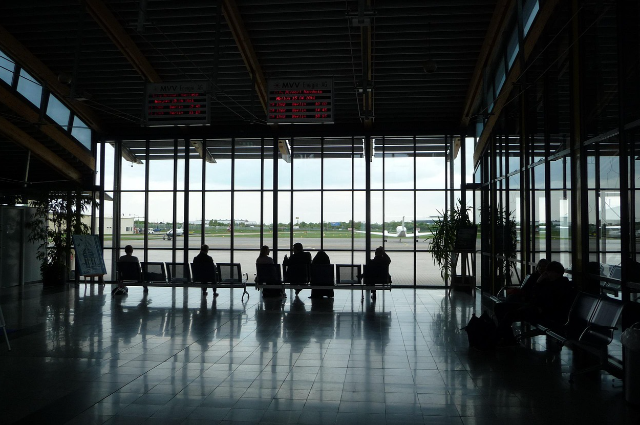
Airports are not just places of coming in and going out, but the places of transition where the movement and the stillness coexist simultaneously. In terminals, passengers are subjected to an unnatural combination of excitement, fear, boredom, and brief happiness. You can hear announcements, the wheels of your luggage rolling on the floors, and the planes are taxiing on the runways, which is both an urgent and slow rhythm. Time is elastic in such a setting: a couple of minutes may turn into hours, and waiting is inevitable. Airports compel people to face some stops in their lives, which can teach them patience, observation and acceptance. The apparently simple process of waiting, in this case, turns out to be a mindfulness practice, and it teaches us something about human beings and the universal process of transitions. Through the analysis of the stillness of transit, the viewer starts to realise how much more airports reflect life itself and how they teach us to deal with uncertainty gracefully.
Airports as a Microcosm of Life
Airports are a miniature of life as terminals record every possible human feeling and action. Some families cluster around gates, businesspeople who walk with haste and those who go into corners with headphones or books. The airport is a place where farewells and welcomes are mixed: weeps and welcomes mingle, and silent waiting are all present at the same time. These instances emphasise the impermanence of human experiences, which reminds the travellers of the ever-changing nature of life. Regular life activities are put on hold, and observation and reflection can be done. Even simple things, such as drinking a cup of coffee and watching planes taxi or staring at departure boards, acquire a new meaning in this liminal condition. Airports disclose that waiting is not merely a state of rest but a possibility to see the rhythm of life, learn human behaviour, and feel the beauty that can be found in the moments of ordinary life.
The Art of Patience
The most immediate lesson that airports provide is probably patience. Security queues are endless, flights are postponed, and gates are swapped at any time, leaving the traveller to deal with situations that are not within their control. These delays are welcomed by some passengers, as they read, write, or make friends with other passengers, and are not welcomed by others, who fidget and pace, trying to restore some semblance of order. Waiting is turned into a mindful practice in the airport. Travellers learn to be resilient by embracing uncertainty and learning to spend time productively, which doesn’t end when they leave the terminal.
Delays, which previously were a cause of frustration, have been turned into moments of contemplation and silent reflection. Airports prove that patience is not a simple endurance, but a skill that can be developed and helps people to handle the inconveniences in their travels and in their lives calmly and clearly.
Observing Humanity in Motion
Airports are arenas of the human state. The variety of emotions can be felt in the breathless business traveller who is in a hurry to make a connection to the wide-eyed tourist who is amazed at the terminal. Small dramas unfold everywhere: a mother comforting a crying baby, a couple quarrelling because the luggage was lost, a reunion with laughter and tears. The observation of these interactions makes us empathise, and we are reminded that not all people deal with time and waiting in the same way. Airports demonstrate the chaos and vulnerability of human life, depicting the interdependence of personal narratives. These remarks make the travellers think about their own feelings and reactions and emphasise the universality of patience, stress, joy, and anticipation. By doing so, airports have been used as learning centres regarding human behaviour and the development of compassion.
Embracing Uncertainty and Letting Go
Airports remind travellers that control is often an illusion. The weather delays, lost luggage, and unforeseen cancellations are those circumstances that are beyond anyone’s control. One of the most important lessons at the airport is to learn how to accept unpredictability. Travellers learn that releasing frustration and concentrating on what is controllable, such as reading a book, watching the surroundings or talking to other passengers, can make the unpleasant experience a worthwhile experience. Such submission to uncertainty is a lesson in resilience and flexibility, which is not only useful in travelling but also in life. When travelling, one learns to be quiet and to feel at peace in the middle of the storm, and that is where the quiet power is, and that there are times when the only way to go is to be still.
After all, airports are not merely functional places, but the arenas of contemplation, tolerance, and comprehension. Waiting in transit is not nothingness but a place full of wisdom, observation and silent discovery. Airports also teach that stillness is not a wasted time, but a time to learn about oneself, learn about other people, and find a way to go through the uncertainties of life with grace. The experiences gained in terminals like patience, empathy, resilience, and mindful presence have a long-lasting impact beyond the journey itself. By embracing the silence of transit, travellers are taught to move on in life, not only physically but also mentally and emotionally, carrying the silent wisdom of waiting. Airports, ironically, demonstrate that to move forward, one has to stop.
